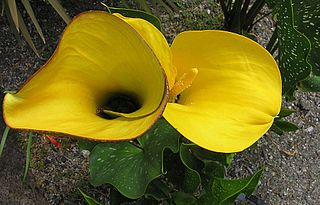Leucadendron cryptocephalum, the concealed conebush, is a flower-bearing shrub that belongs to the genus Leucadendron and forms part of the fynbos. The plant is native to the Western Cape and only two populations occur at Potberg and the Groenlandberg. There is little information available about the plant.

Leucadendron pubescens, the grey conebush, is a flower-bearing shrub belonging to the genus Leucadendron and forms part of the fynbos. The plant is native to the Western Cape where it occurs on the Bokkeveldeskarp, Gifberg, Cederberg, Piketberg, Olifantsrivier, Sandveld, Koue Bokkeveld, Hexrivierberge, Bonteberg as well as the Kwadouwberg, Witteberg and Touwsberg.
Serruria candicans, the shiny spiderhead, is a flower-bearing shrub that belongs to the genus Serruria and forms part of the fynbos. The plant is native to the Western Cape, where it occurs from Elandskloof to the Slanghoek Mountains and Paardeberg at Malmesbury. The shrub is erect and grows only 80 cm tall and bears flowers from July to December.
Berzelia cordifolia is a shrub that belongs to the Bruniaceae family. The species is endemic to the Western Cape and is part of the fynbos. The plant occurs from the Potberg in the De Hoop nature reserve to the Breede River estuary at Infanta. It has an area of occurrence of 150 km2 and there are eight subpopulations. The species is threatened by invasive plants and coastal development.

Clivia gardenii is a plant and geophyte belonging to the genus Clivia. The species occurs in KwaZulu-Natal from the Ngome Forests to the KwaZulu-Natal Midland and has an area of occurrence of 6,900 km2. There are currently less than ten subpopulations and the species has lost 30% of its habitat in the last 90 years due to its excessive use by traditional healers as well as its collection by horticulturalists. The planting of plantations, crop cultivation and development are also threats.

Clivia robusta is a plant and geophyte belonging to the genus Clivia. The species occurs in KwaZulu-Natal and the Eastern Cape from Pondoland and Port St. Johns to the uMzimkhulu River north of the Oribira Canyon and has an area of occurrence of 3,100 km2. There are currently less than ten subpopulations and the species has lost 30% of its habitat in the last 90 years due to overuse by traditional healers.
Erica amoena is a plant that belongs to the genus Erica and forms part of the fynbos. The plant is endemic to the Western Cape and occurs, among other things, in the Table Mountain National Park. The plant is considered rare.

Zantedeschia jucunda, the Highveld golden arum, is a perennial, flowering plant and geophyte that is part of the Araceae family. The species is endemic to Limpopo and occurs on the summit of the Leoloberge. The plant has an area of occurrence of less than 380 km2. The plant is threatened by illegal collection by humans as well as mining and human activities.

Dimorphotheca venusta is a plant belonging to the genus Dimorphotheca. The species is endemic to the Western Cape and occurs in the Wemmershoek, Du Toitskloof and Hexrivier mountains at altitudes of 600 - 1,800 m. The plant is considered rare. The species was described by Nils Tycho Norlindh in 1980.
Berzelia burchellii is a shrub that belongs to the family Bruniaceae.
Berzelia ecklonii is a shrub that belongs to the Bruniaceae family. The species is endemic to the Western Cape and is part of the fynbos. The plant occurs in the mountains between Grabouw and Pringle Bay. It has an area of occurrence of 272 km2 and the plant is considered rare.

Berzelia rubra is a shrub that belongs to the family Bruniaceae. The species is endemic to the Western Cape and is part of the fynbos. The plant occurs in the Kleinrivier Mountains and has an area of occurrence of less than 10 km2. The plant is threatened by the invasive plants such as Pinus and Hakea species.

Aloe framesii is a plant belonging to the genus Aloe. In South Africa, the species is native to the Western Cape and the Northern Cape and occurs on the coast from Port Nolloth to Saldanha Bay.

Haemanthus deformis is a perennial flowering plant and geophyte belonging to the genus Haemanthus. The species is endemic to the Eastern Cape and KwaZulu-Natal and occur from Umtata to Durban. The plant only grows in the forests near the coast and is threatened by the traditional medicine industry.

Haemanthus humilis is a perennial flowering plant and geophyte belonging to the genus Haemanthus. The species is native to South Africa, it occurs in every province, as well as Botswana and Lesotho.

Haemanthus lanceifolius is a perennial flowering plant and geophyte belonging to the genus Haemanthus.

Haemanthus montanus is a perennial flowering plant and geophyte belonging to the genus Haemanthus. The species are native to Gauteng, KwaZulu-Natal, Mpumalanga, North West, Eastern Cape and the Free State as well as Botswana.
Haemanthus namaquensis is a perennial flowering plant and geophyte that belongs to the genus Haemanthus and is part of the Succulent Karoo vegetation. The species is native to the Northern Cape and Namibia. It occurs from southern Namibia to Karkams in Namaqualand. There are eight subpopulations in an area of occurrence of 4000 km2, the plant is considered rare.

Haemanthus nortieri is a perennial flowering plant and geophyte belonging to the genus Haemanthus. The species are endemic to the Western Cape and occur on the Nardouwberg. The plant has an area of occurrence smaller than 100 km² and there are three subpopulations. It is threatened by overgrazing and trampling by livestock, road construction, invasive plants and illegal collection by horticulturists.
Haemanthus tristis is a perennial flowering plant and geophyte belonging to the genus Haemanthus. The species is endemic to the Northern Cape and the Western Cape and occurs in the southeastern Tankwa Karoo, where there are five subpopulations.












